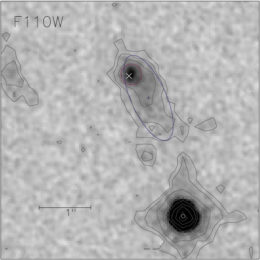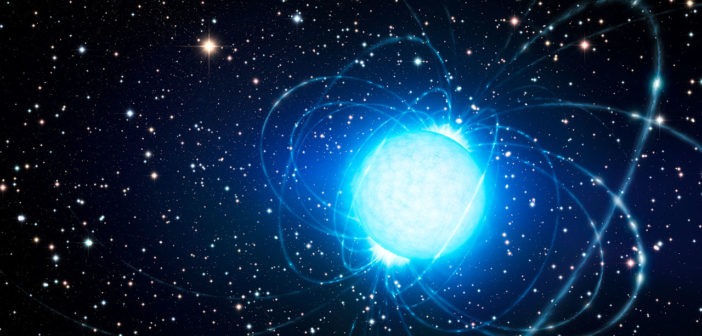The origin of the mysterious fast radio bursts has eluded us for more than a decade. With the help of a particularly cooperative burst, however, scientists may finally be homing in on the answer to this puzzle.
A Burst Repeats
More than 20 fast radio bursts — rare and highly energetic millisecond-duration radio pulses — have been observed since the first was discovered in 2007. FRB 121102, however, is unique in its behavior: it’s the only one of these bursts to repeat. The many flashes observed from FRB 121102 allowed us for the first time to follow up on the burst and hunt for its location.Earlier this year, this work led to the announcement that FRB 121102’s host galaxy has been identified: a dwarf galaxy located at a redshift of z = 0.193 (roughly 3 billion light-years away). Now a team of scientists led by Cees Bassa (ASTRON, the Netherlands Institute for Radio Astronomy) has performed additional follow-up to learn more about this host and what might be causing the mysterious flashes.

Hubble observation of the host galaxy. The object at the bottom right is a reference star. The blue ellipse marks the extended diffuse emission of the galaxy, the red circle marks the centroid of the star-forming knot, and the white cross denotes the location of FRB 121102 ad the associated persistent radio source. [Adapted from Bassa et al. 2017]
Host Observations
Bassa and collaborators used the Hubble Space Telescope, the Spitzer Space Telecsope, and the Gemini North telecsope in Hawaii to obtain optical, near-infrared, and mid-infrared observations of FRB 121102’s host galaxy.
The authors determined that the galaxy is a dim, irregular, low-metallicity dwarf galaxy. It’s resolved, revealing a bright star-forming region roughly 4,000 light-years across in the galaxy’s outskirts. Intriguingly, the persistent radio source associated with FRB 121102 falls directly within that star-forming knot.
Bassa and collaborators also found that the properties of the host galaxy are consistent with those of a type of galaxy known as extreme emission line galaxies. This provides a tantalizing clue, as these galaxies are known to host both hydrogen-poor superluminous supernovae and long-duration gamma-ray bursts.
Linking to the Cause
What can this tell us about the cause of FRB 121102? The fact that this burst repeats already eliminates cataclysmic events as the origin. But the projected location of FRB 121102 within a star-forming region — especially in a host galaxy that’s similar to those typically hosting superluminous supernovae and long gamma-ray bursts — strongly suggests there’s a relation between these events.

Artist’s impression of a gamma-ray burst in a star-forming region. [NASA/Swift/Mary Pat Hrybyk-Keith and John Jones]
This picture may finally explain the cause of fast radio bursts — but Bassa and collaborators caution that it’s also possible that this model applies only to FRB 121102. Since FRB 121102 is unique in being the only burst discovered to repeat, its cause may also be unique. The authors suggest that targeted searches of star-forming regions in galaxies similar to FRB 121102’s host may reveal other repeating burst candidates, helping us to unravel the ongoing mystery of fast radio bursts.
Citation
C. G. Bassa et al 2017 ApJL 843 L8. doi:10.3847/2041-8213/aa7a0c


5 Comments
Pingback: Posible explicación para FRB 121102. | Pablo Della Paolera
Pingback: AAS Nova – New
Pingback: A Fast Radio Burst Every Second?
Pingback: Het mysterie van de snelle radioflitsen opgelost?
Pingback: What Galaxies Reveal About Magnetars and Fast Radio Bursts